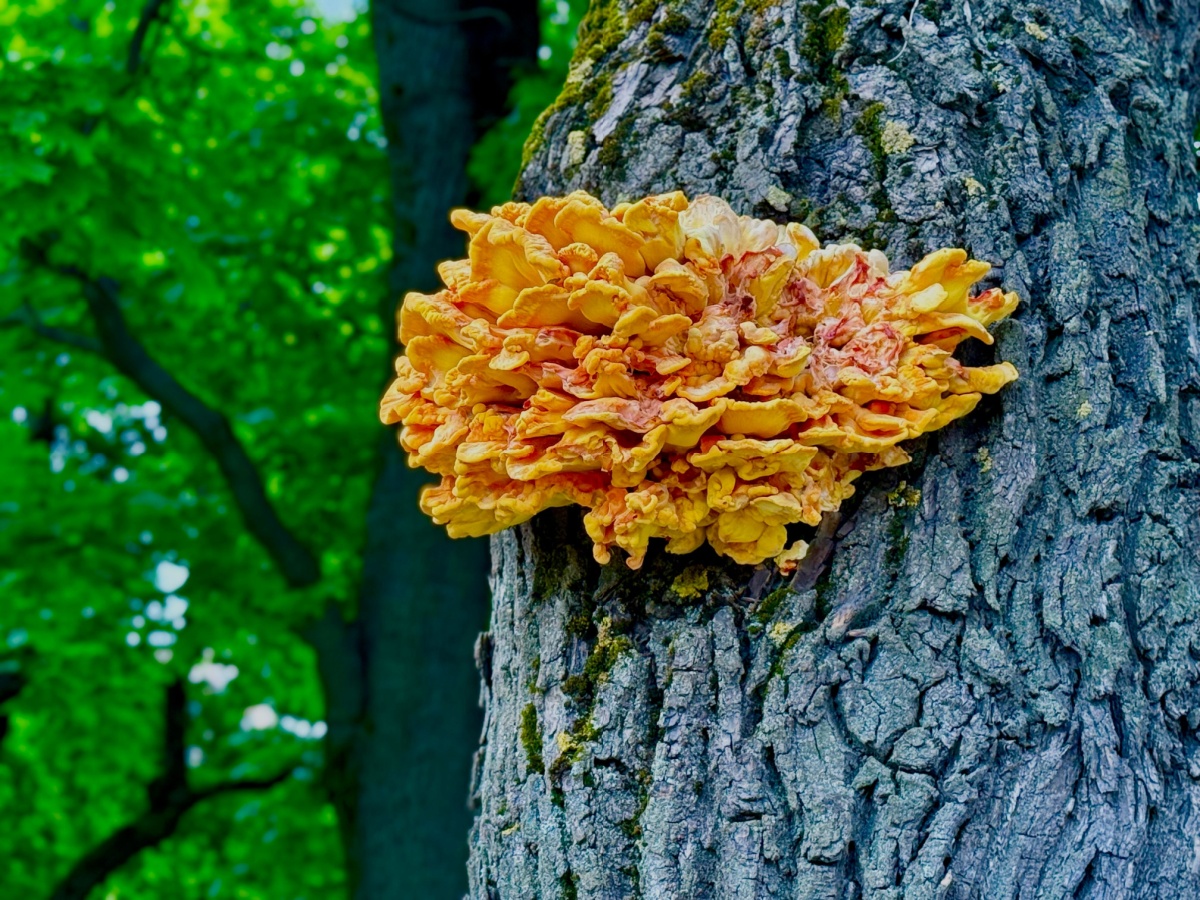
Fungal infections in trees can present themselves in a wide variety of ways, from clusters of mushrooms at the base of a tree to dark lesions on leaves and wilting branches. Without a doubt, all of these problems can be alarming and unsightly. They also often raise concerns about tree health and safety. Fortunately, fungal infections don’t have to mean the end of your beloved tree. With the right approach, you can mitigate the growth of harmful fungi and help your trees thrive once more.
How to Spot Tree Fungal Diseases
Have you ever wondered if the discoloration on your tree’s leaves is just a normal part of its life cycle or a sign of something more troublesome? We understand why it can be confusing to pinpoint the exact reason your tree’s appearance has changed. After all, fungi alone can cause a range of symptoms, and these issues can sometimes be signs of other diseases or even nutrient deficiencies. With so many factors at play, it only makes sense to hire a trained arborist to diagnose the specific disease your tree is facing.
So, if you notice any of the following problems that often indicate a fungal tree disease, contact Heartwood Tree Care right away:
- Leaf Spots: These spots can be brown, black, tan, or even purple. They might appear as small, distinct dots, or they can merge into large, irregular blotches that consume large portions of the leaf. In severe cases, this can lead to shot hole disease, where the dead spots fall out, leaving the leaf looking as though it was hit with buckshot.
- A Powdery or Fuzzy Coating on Leaves: Powdery mildew, for instance, looks like a dusting of white or gray powder and often appears on the upper surfaces of leaves, particularly on species like dogwoods, crape myrtles, and oaks.
- Cankers on Branches or the Trunk: Cankers can appear sunken and discolored and sometimes ooze sap or a dark fluid. These open wounds cut off the flow of water and nutrients and eventually kill the limb.
- Unusual Growths: Sometimes, a fungal infection causes the tree to grow in strange ways. Galls are abnormal growths or swellings of plant tissue that can appear on leaves, twigs, or branches. These growths, while often not fatal, can disfigure a tree and indicate an underlying health issue.
- Mushrooms and Conks: If you see mushrooms, conks, or other fungal fruiting bodies growing directly on the trunk, branches, or roots of your tree, there is likely significant internal rot. Rotting can compromise the tree’s structural integrity even if the canopy still looks relatively healthy, so you will want to have a certified arborist address a rotting tree right away.
Common Tree Fungi in North Carolina
While countless species of fungi exist, certain types are particularly troublesome for trees in North Carolina. Knowing the common culprits can help you and your arborist narrow down the diagnosis.
Anthracnose
Anthracnose is a broad term for a group of fungal diseases that cause dark, sunken lesions on leaves, stems, flowers, and fruits. It’s especially common on dogwoods, sycamores, maples, and oaks. During our cool, wet springs, anthracnose can cause significant leaf spotting and blight, often concentrated along the leaf veins. In sycamores, it can lead to extensive twig dieback and give the tree a gnarled, unhealthy appearance year after year.
Powdery Mildew
Powdery mildew loves the humidity in North Carolina and affects a wide range of ornamentals. While it may not kill a mature, healthy tree, it can severely weaken younger plants and significantly detract from the beauty of iconic species like the flowering dogwood.
Root Rot
Have you noticed mushrooms or shelf-like conks growing at the base of your tree or on its roots? These are often the fruiting bodies of pathogens like Armillaria and Phytophthora. They thrive in poorly drained, compacted, or overly wet soils and eventually cause yellowing leaves, a thinning canopy, and branch dieback. Unfortunately, this is one of the most serious and difficult-to-treat fungal problems.
Oak Wilt
Caused by the fungus Bretziella fagacearum, oak wilt is a lethal vascular disease that can kill a red oak in a matter of weeks. The fungus spreads through interconnected root systems and by beetles that carry spores from infected trees to fresh wounds on healthy ones. Symptoms include rapid wilting and browning of leaves, starting from the top of the tree and moving down.
Cedar-Apple Rust
This disease requires two different host plants to complete its life cycle: a juniper (often the Eastern Red Cedar) and an apple or crabapple. On the juniper, it forms a grotesque, orange, gelatinous gall in the spring. Spores from this gall travel on the wind to infect nearby apple trees, causing bright yellow-orange spots on their leaves and fruit.
How to Address Fungal Problems in Trees
Once a fungal infection is identified, prompt treatment is essential. Before we get into the different treatment options for tree fungal diseases, it’s important to note that treatment is rarely completed in a single application. In fact, not all fungi can be eradicated completely, and problems need to be managed with an integrated plant health program.
Cultural Practices
The best way to fight fungus is to create an environment where it can’t thrive. The best way to do this is to follow these key tips for keeping trees healthy:
- Rake Up Leaves: Many fungi overwinter on fallen leaves and infected twigs. In the fall, be diligent about raking up all debris from around an infected tree. This single act can dramatically reduce the number of fungal spores available to re-infect the tree the following spring.
- Hire an Arborist to Prune Your Tree: An arborist can thin the canopy to improve air circulation and sunlight penetration, which helps leaves dry more quickly and creates a less hospitable environment for fungi. They can also remove any dead, dying, or canker-infected branches.
- Water Wisely: Use a soaker hose or drip irrigation to deliver water directly to the root zone, and water deeply but infrequently to discourage soil-borne pathogens that love consistently soggy conditions.
- Mulch, But Don’t Smother the Tree: Mulch is excellent for retaining soil moisture and regulating temperature, but it must be applied correctly. Keep mulch 6 inches away from the tree’s trunk to prevent moisture from being trapped against the bark, which can lead to collar rot.
Fungicide Treatments
For persistent or aggressive diseases, more direct intervention may be required. For example, topical fungicides (usually applied as a spray) can be effective at protecting new, emerging leaves from infection. The key thing to understand is that most fungicides are preventative, not curative. They create a protective barrier on the leaf surface but won’t heal tissue that is already infected. This means timing is absolutely critical.
For diseases that are inside the tree’s vascular system (like oak wilt) or attacking its roots, systemic products can be applied as a soil drench or through a trunk injection. An injection delivers the fungicide or other treatment product directly into the tree’s transport tissues, allowing it to be distributed throughout the canopy and roots. This is a highly specialized procedure that must be performed by a certified arborist to make sure it is done safely and effectively.
Tree Removal
In cases of severe infection, particularly with wood-decay fungi, tree removal may be the safest option. This is because the fungi can compromise structural integrity, making the tree susceptible to collapse at any moment.
Get an Expert Opinion on Your Tree’s Health
Do you suspect that your trees or shrubs are being affected by fungi? The best step you can take is to schedule an inspection with an ISA-certified arborist at Heartwood Tree Care. Our trained professionals can identify the exact fungal pathogen affecting your tree and develop a customized, multi-faceted treatment plan to give your tree its best chance at recovery and a long, healthy life.
Contact Heartwood Tree Care today to schedule your consultation and learn more about your plant health care options for treating tree fungal diseases.
